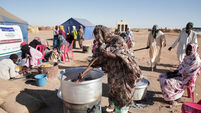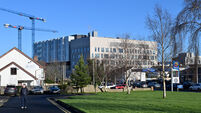Efforts to cool reactor continue
Emergency workers are continuing frantic efforts to cool nuclear fuel at Japan’s stricken reactors complex.
They tried with police water cannons, heavy-duty firetrucks and military helicopters dropping bucket after enormous bucket of water onto the plant.
By nightfall, it was not clear if anything had worked, and the UN nuclear agency warned the situation was “very serious” but “reasonably stable”.
US and Japanese officials gave differing assessments of what was happening at the Fukushima Dai-ichi nuclear plant, 140 miles (220 kms ) north of Tokyo.
The top US nuclear regulatory official warned of possible high emissions of radiation while the US ambassador urged Americans within 50 miles (80 kms) of the plant on the tsunami-savaged north-eastern coast to leave the area or at least remain indoors.
Tokyo Electric Power Co, which owns the plant, said it believed workers were making headway in staving off a catastrophe both with the spraying and, especially, with efforts to complete an emergency power line to restart the plant’s own electric cooling systems.
“This is a first step toward recovery,” said Teruaki Kobayashi, an official at the power company.
He said radiation levels “have somewhat stabilised at their lows” and that some of the spraying had reached its target, with one reactor emitting steam.
“We are doing all we can as we pray for the situation to improve,” Kobayashi said.
Authorities planned to spray again.
The troubles at the nuclear complex were set in motion by last Friday’s 9.0-magnitude earthquake and tsunami, which knocked out power and destroyed backup generators needed for the reactors’ cooling systems.
That added a nuclear crisis on top of twin natural disasters that are likely to have killed well over 10,000 people and left hundreds of thousands homeless.
Four of the plant’s six reactors have seen fires, explosions, damage to the structures housing reactor cores, partial meltdowns or rising temperatures in the pools used to store spent nuclear fuel.
Officials also recently said temperatures are rising in the spent fuel pools of the last two reactors.
Two Japanese military CH-47 Chinook helicopters began dumping seawater on the complex’s damaged Unit 3 today.
The choppers doused the reactor with at least four loads of water in just the first 10 minutes, though television footage showed much of it appearing to disperse in the wind.
Chopper crews flew missions of about 40 minutes each to limit their radiation exposure, passing over the reactor with loads of about 2,000 gallons (7,500 litres) of water.
Another 9,000 gallons (35,000 litres) of water were blasted from military trucks with high-pressure sprayers used to extinguish fires at plane crashes, though the vehicles had to stay safely back from areas deemed to have too much radiation.
Special police units with water cannons, however, could not reach the targets from safe distances and had to pull back.
The dousing was aimed at cooling the Unit 3 reactor, as well as replenishing water in that unit’s cooling pool, where used fuel rods are stored.
The plant’s owner, Tokyo Electric Power Co., said earlier that that pool was nearly empty, which would cause the rods to overheat and emit even more radiation.
Of concern is that Unit 3’s reactor uses a fuel that combines plutonium, better known as an ingredient in nuclear weapons, and reprocessed uranium.
The presence of this mixed oxide fuel, or MOX, means potentially that yet another very harmful radioactive product could be released into the environment - plutonium.
US officials, meanwhile, said Unit 4 also was seriously at risk, with a particularly dire warning coming from US Nuclear Regulatory Commission Chairman Gregory Jaczko.
At a congressional hearing in Washington, Jaczko said that all the water was gone from that unit’s spent fuel pool and anyone who gets close to the plant could face potentially lethal doses of radiation.
“We believe radiation levels are extremely high,” he said.
Tokyo Electric executives said they believed the rods in that pool were covered with water, but an official with Japan’s nuclear safety agency later expressed scepticism about that and moved closer to the US position.
“Considering the amount of radiation released in the area, the fuel rods are more likely to be exposed than to be covered,” Yuichi Sato said.
So just what is happening is unclear.
Graham Andrew, a senior official of the UN's International Atomic Energy Agency, said the situation remained ``very serious'' but also noted that ``there has been no significant worsening'' at the plant over the previous 24 hours.
He spoke shortly after IAEA chief Yukiya Amano flew to Tokyo to assess the relief efforts.
Mario Bonaca, a physicist sits on an advisory committee to the US Nuclear Regulatory Commission, said he believes the focus of the effort has shifted to the spent fuel pools.
“I understand that they’ve controlled the cooling of the cores,” said Bonaca, who said he was basing his understanding on NRC and industry sources.
Power company officials said the water levels were low in the three most troubled reactors, with half of the fuel rods exposed.
The storage pools need a constant source of cooling water. Even when removed from reactors, uranium rods are still extremely hot and must be cooled for months, possibly longer, to prevent them from heating up again and emitting radioactivity.
While a core team of 180 emergency workers has been rotating in and out of the complex to avoid exposure, experts said that anyone working close to the reactors was almost certainly being exposed to radiation levels that could, at least, give them much higher cancer risks.
Experts note, though, that radiation levels drop quickly with distance from the complex. While elevated radiation has been detected well outside the evacuation zone, experts say those levels are not dangerous.
US officials were taking no chances. In Washington, the State Department warned US citizens to consider leaving the country and offered voluntary evacuation to family members and dependants of US personnel in the cities of Tokyo, Yokohama and Nagoya.
Plans also call for airlifting several thousand family members of US armed forces personnel as well as non-essential staff stationed in Japan in the coming days.
Nearly a week after the disaster, police said more than 452,000 people were staying in schools and other shelters, as supplies of fuel, medicine and other necessities ran short. Both victims and aid workers appealed for more help, as the chances of finding more survivors dwindled.
Noriko Sawaki lives in a battered neighbourhood in Sendai that is still without running water and food or petrol supplies and that, she said, makes life exhausting. “It’s frustrating, because we don’t have a goal, something to strive for. This just keeps on going,” said the 48-year-old.
In the town of Kesennuma, they lined up to get into a supermarket after a delivery of key supplies, such as instant rice packets and diapers.
Each person was only allowed to buy 10 items, NHK television reported.














